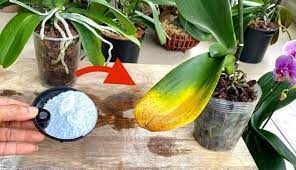In this article, we’ll delve into why incorporating baking soda into your orchid care routine can work wonders. If you’re like me, a devoted orchid enthusiast, you’ll be delighted with these insights, particularly if you’re aiming to rejuvenate their blossoms. It was my trusted nurseryman who enlightened me about the remarkable benefits of baking soda for these delicate plants. Ever since I introduced it to them, the transformation has been nothing short of magnificent. Let’s explore four compelling reasons to introduce baking soda into your orchid’s potting mix.
- Baking Soda Stimulates Orchid Flowering Orchids are renowned for their stunning blooms. However, once their flowers wither away, their aesthetic appeal diminishes. Reviving their blossoms can be quite a challenge. Everyone has their own unique tricks or ancestral secrets, but my nurseryman shared his greenhouse-proven method: baking soda. To stimulate the flowering of your Bamboo, Phalaenopsis, or Cambria orchids, prepare this mixture: – 1 tablespoon of bicarbonate in 1 liter of room-temperature water. Stir thoroughly and apply the solution at the base of the plant, preferably through spraying, about one month after deflowering. Some individuals choose to add a small amount of dishwashing liquid to enhance binding, although personally, I prefer a more natural approach.
- It Serves as a Natural Fertilizer Orchids boast beautiful flowering branches, but at their core, they are still plants. Just like any other plant, they occasionally require a little nourishment to thrive. Mixing 1 tablespoon of baking soda with 1 liter of water and watering the plant is a fantastic natural fertilizer solution. The recommended frequency is three or four times in succession, approximately one month after flowering, and can be repeated annually if necessary. Bicarbonate functions as a fertilizer, all while staying 100% natural. However, it’s essential not to overuse this mixture. There should be occasional fertilization gaps. Above all, never apply it when the plant is in bud or flowering!
- It Extends the Orchid’s Lifespan Much like any other fertilizer, bicarbonate contributes to the longevity of plants. How does it do that? It provides essential nutrients crucial for the orchid’s overall health, particularly sodium and carbon. These elements are required once or twice a year, making it beneficial to schedule a brief treatment outside of the flowering season. You can also achieve similar results with a magical potion crafted from potato peelings. Do you find this tip intriguing? Join our community of already 3 million readers and receive the best tips each morning, free from spam and promises!
- It Corrects the Substrate’s pH Another crucial aspect to consider is how bicarbonate improves or adjusts the pH of the potting soil or substrate. This is vital for an orchid’s well-being since it thrives in slightly acidic environments, with a preferred pH range of around 5 to 6. If you’re using tap water to irrigate your orchid, its pH may be too high or too low, depending on your location. To determine your water’s quality, use pH test strips. If the pH is too low, add a small amount of bicarbonate to your watering water to rebalance it. It’s advisable to prepare your watering water a day in advance and allow it to dissolve overnight for best results.
Show Comments



